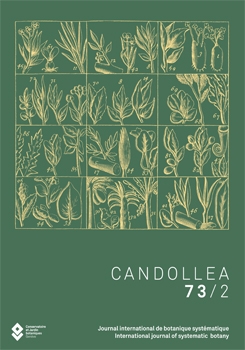Mazumdar, J. & M.W. Callmander (2018). Lectotypification of the N.L. Burman’s fern name Adiantum denticulatum. Candollea 73: 217–220. In English, English abstract. DOI: http://dx.doi.org/10.15553/c2018v732a6
The fern name Adiantum denticulatum Burm. f. was published by Nicolaas Laurens Burman (1734–1793) in his Flora Indica: cui accedit series zoophytorum indicorum, nec non prodromus florae capensis in 1768. Original material of this name included specimens from his own herbarium (now conserved in Geneva under the acronym G-PREL) and an illustration from Leonard Plukenet's Phytographia. The history of the typification of this fern name is reviewed and a Franciscus Albertus Pryon collection from Java in G-PREL is designated as second-step lectotype.
Received: May 26, 2018. Accepted: August 24, 2018. First published online: November 5, 2018.
Introduction
Burman (1768)'s Flora Indica: cui accedit series zoophytorum indicorum, nec non prodromus florae capensis [Flora Indica] represents an early and important contribution to what was known of the flora of the South and Southeast Asia in the 18th Century. Nicolaas Laurens Burman (1734–1793), son of Johannes Burman (1706–1779), described in this work c. 1350 species, of which 241 were proposed as new (Merrill, 1921). Burman filius went in 1760 to study under his father's friend, Carl Linnæus (1707–1778), in Uppsala (Stafleu, 1971). Therefore, Flora Indica was published under the Linnaean system of binomial classification and several names published in this work are still in use.
The Burman herbarium was bought by Benjamin Delessert (1773–1847) in 1801 on the advice of Augustin-Pyramus de Candolle (1778–1841), who had heard about it during a trip to Holland in 1799 (see Candolle, 2004). The 29,000 plants of the Burman herbarium included collections from the Burmans but also the main set of Martinus Houttuyn (1720–1798)'s herbarium (Lasègue, 1845; Staples & Jacquemoud, 2005; Wijnands et al., 2017). This herbarium is now stored as a separate historical herbarium in Geneva with the acronym G-PREL.
Merrill (1921) was a pioneer in reviewing the names published in N.L. Burman's Flora Indica. Although none of the original material in the Delessert herbarium (now in G-PREL) was available to Merrill and his interpretations were based only on descriptions (see Merrill, 1921: 331–332), he nevertheless reviewed the nomenclature and typification of 20 fern names out of the 25 proposed as new by N.L. Burman (Merrill, 1921: 333–337). The first author has undertaken a complete review of all the new fern names published in Flora Indica, that will be ultimately published.
The fern Adiantum denticulatum Burm. f. (currently accepted under Davallia denticulata (Burm. f.) Mett. ex Kuhn (Davalliaceae)) was described by Burman (1768: 236) based on a Pryon collection from Java and an illustration from Plukenet (1692: tab. 180, Fig. 4)'s Phytographia. However, as emphasized by Merrill (1921: 333), Burman mentioned in the protologue that Pryon's collection differed slightly from Plukenet's illustration, but nonetheless cited both as original material.
Merrill (1921) stated that “The actual type is a Javan specimen collected by Pryon,” but did not see the specimen. Subsequent floristic treatments for Africa and the Mascarenes followed Merrill by citing “Pryon s.n., holo., G-DEL” (e.g. Verdcourt, 1999; Badré, 2008). On the other hand, Nooteboom (1994, 1998, 2013) in his various revisions of the genus Davallia Sm. in Southeast Asia considered Plukenet (1692)'s illustration as type. Finally, Morton (1974: 383) cited as holotype “Java, Burmann, Morton photograph 16909″ in G. This photograph shows a label with the phrases “Planta Ind. Or. Javanica” and “Adiantum denticulatum. Burm.” in Houttuyn's handwriting. It cannot be considered as original material, as it was part of Houttuyn's herbarium (see Wijnands et al., 2017 and citations herein).
Merrill (1921: 333) was the first to select a Pryon specimen over Plukenet's illustration as type material, and this should be considered an implicit valid lectotypification under the ICN (Turland et al., 2018: Art. 9.19).
However, instead of one unambiguous specimen, two specimens collected by Pryon are present in G-PREL [G00800169, G00800170], both with Pryon's handwriting and representing original material. Thus a second-step lectotypification is necessary as recommended by ICN (Turland et al., 2018: Art. 9.17) and designated below.
Lectotypification
Adiantum denticulatum Burm. f., Fl. Ind.: 236. 1768.
≡ Davallia denticulata (Burm. f.) Mett. ex Kuhn, Filic. Afr.: 27. 1868.
Lectotypus (first step designated by Merrill, 1921: 333; second step designated here): Indonesia. Java: s.d., Pryon s.n. (G-PREL [G00800170]!). Syntypus: Indonesia. Java: s.d., Pryon s.n. (G-PREL [G00800169]!).
Notes.–Davallia denticulata has been considered as widely distributed from Africa to the Pacific Islands, including the Indian Ocean islands, India, Southeast Asia and Australia (Verdcourt, 1999; Noteboom, 2013; Xing et al., 2013). However, recent molecular phylogenetic studies have concluded that the African plants are different and should be named D. chaeropylloides (Poir.) Steud. (Tsutsumi et al., 2008, 2016). Therefore, the African and Occidental Indian Ocean Islands plants are treated as a distinct but allied species (Roux, 2009; Crouch et al., 2011; APD, 2018; Madagascar Catalogue, 2018) and D. denticulata is restricted to Asia and the Pacific Islands.
In the preface of Flora Indica, N.L. Burman considered Pryon to be “among the most excellent botanists” (see Florijn, 1987: 35). Pryon is certainly identical to Franciscus Albertus Prayon, who died in Java in 1765. He was a native of Cologne and travelled to Java on December 1756 for the Dutch East India Company (VOC: Vereenigde Oostindische Compagnie). Correspondence between Pryon and N.L. Burman is kept in the archives of the University of Amsterdam (see van Steenis-Kruseman, 1958).
We designate the sheet G00800170 (Fig. 1) over G00800169, as it represents a more complete specimen and bears the name “Adianthum [sic!] denticulatum” in N.L. Burman's handwriting.
Acknowledgements
We thank Nicolas Fumeaux (G) for his great help in locating original material in G-PREL and fruitful discussions about this historical herbarium, Eric Schuettpelz (US) for sending the Morton photograph, and France Rakotondrainibe (P) for discussion about the taxonomic status of D. denticulata vs D. chaeropylloides in Madagascar and for mentioning several publications related to this article. Finally we thank Michael H. Grayum (MO) and Nicolas Fumeaux for improving an earlier version of this manuscript.







